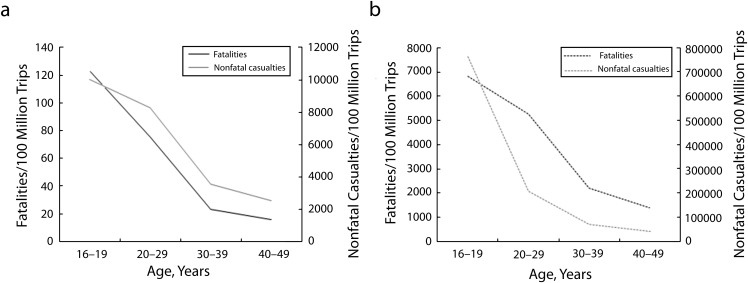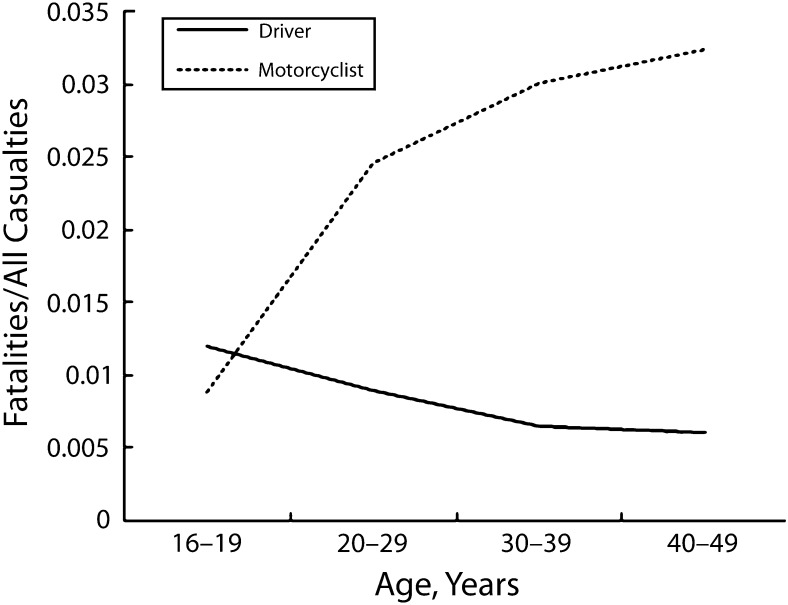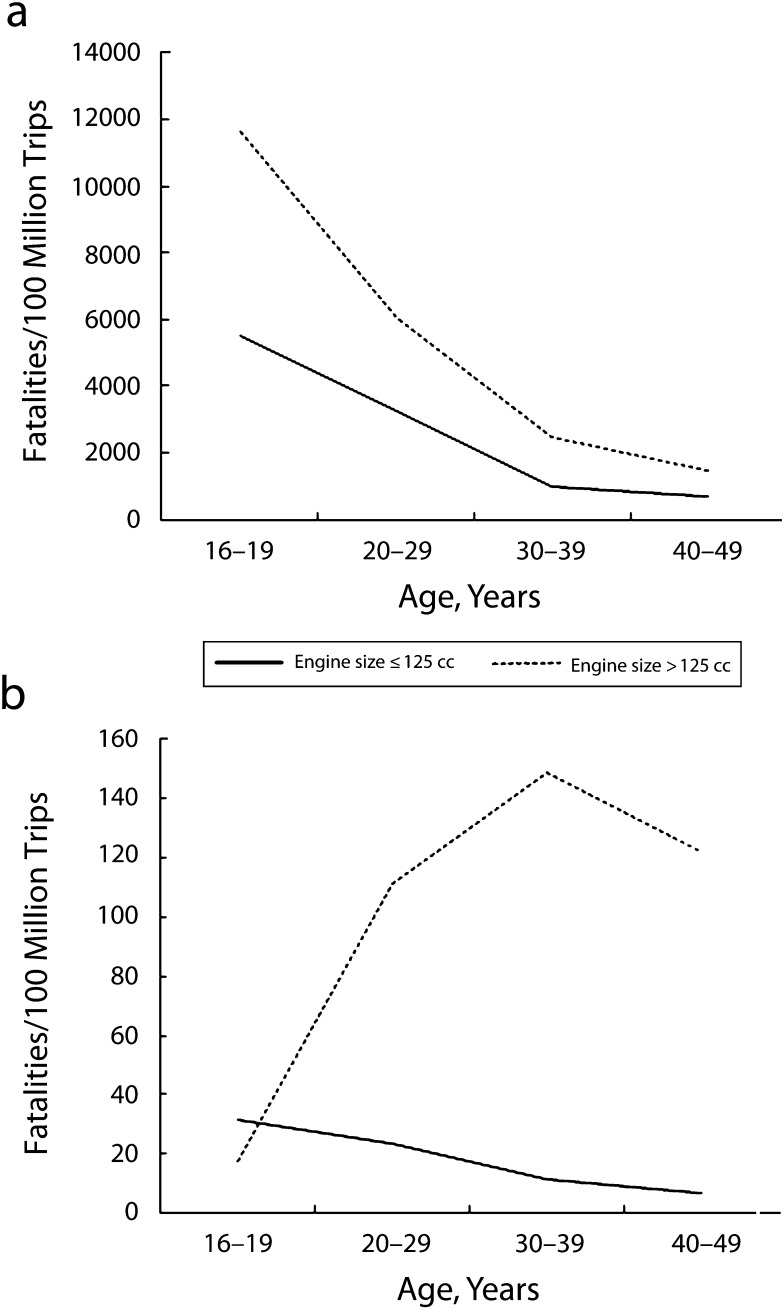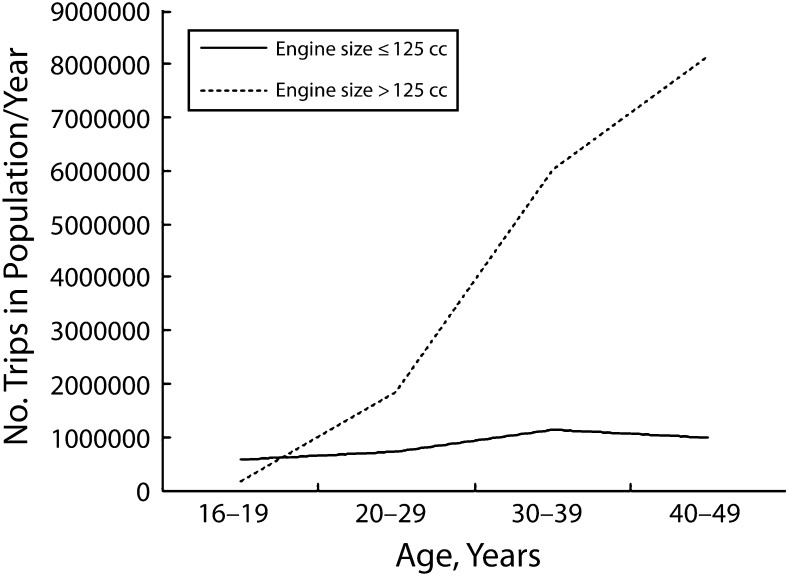Abstract
Objectives. We assessed whether policies designed to safeguard young motorcyclists would be effective given shifts in ownership toward high-powered motorcycles.
Methods. We investigated population-wide motor vehicle driver and motorcyclist casualties (excluding passengers) recorded in Britain between 2002 and 2009. To adjust for exposure and measure individual risk, we used the estimated number of trips of motorcyclists and drivers, which had been collected as part of a national travel survey.
Results. Motorcyclists were 76 times more likely to be killed than were drivers for every trip. Older motorcyclist age—strongly linked to experience, skill set, and riding behavior—did not abate the risks of high-powered motorcycles. Older motorcyclists made more trips on high-powered motorcycles.
Conclusions: Tighter engine size restrictions would help reduce the use of high-powered motorcycles. Policymakers should introduce health warnings on the risks of high-powered motorcycles and the benefits of safety equipment.
The 1969 film Easy Rider depicts the adventure of 2 motorcyclists traveling across the southern and southwestern United States. The film captured the ideals of the biker culture that would reach its heyday in the 1970s and 1980s. But this period also witnessed a surge in motorcyclist fatalities and serious injuries in the United States, which came at enormous financial cost.1 Motorcycle crashes draw heavily on public funds through the demands that motorcyclist injuries place on medical care and treatment and emergency response services as well as through loss of productivity.2,3 It is estimated that the financial burden of collisions in a single year totals around $12 billion in the United States,3 much of which is borne by society through taxes and insurance premiums.
After a lull in motorcyclist deaths and motorcycle registrations in the 1990s, annual fatality counts in the past decade have again begun to rise.1,4 Motorcyclist fatalities had increased for the 11th consecutive year in 2008, rising above the recorded fatality counts that peaked in the late 1970s.1 Between the years 2000 and 2005, the United States saw a 59% increase in motorcyclist fatalities, a 24% increase in nonfatal injuries, and a resulting 39% increase in financial cost.3 Motorcycling has increased in recent years, and fatal and nonfatal injury counts have risen at a greater rate than have motorcycle registrations, indicating that recent trends cannot be explained by motorcycle use alone.1
State helmet laws in the United States have been relaxed in recent years, and many public health researchers contend that this is linked to recent trends in motorcyclist deaths. Fewer deaths are recorded in states that enforce helmet laws than in those that do not,5 and statewide fatality counts are shown to rise when helmet laws are relaxed.6 Yet similar trends in fatality counts have also become apparent in European countries, such as Britain, where helmet laws are enforced for all motorcyclists and have not changed in recent years.7 Thus, the rise in motorcycle fatalities is an international concern for public health. Recent newspaper editorials have called for policy intervention,8 and reports from the American Medical Association have called for initiatives to improve motorcycle safety.9,10
Both in the United States and in Europe, motorcycle ownership has shifted toward higher powered motorcycles. The average engine size of motorcycles involved in fatal collisions has increased with the fatality counts, and the Insurance Institute for Highway Safety recently reported that fatality rates associated with some powerful motorcycles are many times those of less powerful bikes.11 Young motorcyclists are shown to have the highest fatality rates of any age group, perhaps owing to their inexperience, skill level, and risky riding behavior.12 We investigated whether policies aimed at safeguarding young inexperienced motorcyclists would be effective in light of recent shifts in ownership toward more powerful motorcycles.
METHODS
We analyzed motorcyclist and motor vehicle driver casualties as a result of road traffic incidents in Britain (i.e., England, Scotland, and Wales) between the years 2002 and 2009. We did not include passengers. Law enforcement officials collected the data on location, and the University of Essex Data Archive made the data available to us. The UK Department of Transport provided our measure of exposure, which included motorcyclists’ and drivers’ estimated number of trips made per year between 2002 and 2009. The exposure data were collected as part of the UK National Travel Survey, in which respondents recorded their trips made using a travel diary. These data do not include trips that were less than 1 kilometer.
We conducted generalized negative binomial regression with log-link modeling on fatal and nonfatal casualty counts, as McCullagh and Nelder advised for count data.13 We included age range as a factor, categorized as aged 16 to 19, 20 to 29, 30 to 39, or 40 to 49 years. We omitted individuals aged 50 years and older from our analysis because our main concern was the younger and middle aged ranges. In line with the UK Department of Transport and the UK Driver and Vehicle License Agency, we categorized engine size as either 125 cubic centimeters (cc) or less or greater than 125 cc.14 Motorcyclists in the UK are restricted to motorcycles of 125 cc or less until aged 21 years unless the motorcyclist successfully completes a compulsory advanced training course that can be attended when aged 17 years or older.14 We included road user (driver vs motorcyclist) and engine capacity (≤ 125 cc vs > 125 cc) as factors, with year (2002–2009) as a covariate. Our analysis of fatal and nonfatal injury rates included the estimated number of trips drivers and motorcyclists made for each age range as an offset term in our regression analyses.
RESULTS
Motorcyclists were 76.32 (95% confidence interval [CI] = 69.27, 84.10) times more likely to be killed and 27.66 (95% CI = 23.73, 32.24) times more likely to be nonfatally injured for every trip made than were motor vehicle drivers. Figure 1a shows that for drivers, risk of fatal and nonfatal injuries decreased at a similar rate with age. The youngest drivers (16–19 years) were 1.63 (95% CI = 1.42, 1.87), 5.30 (95% CI = 4.61, 6.08), and 7.82 (95% CI = 6.81, 8.98) times more likely to be killed, and 1.22 (95% CI = 1.11, 1.33), 2.84 (95% CI = 2.59, 3.11), and 3.97 (95% CI = 3.62, 4.35) times more likely to be nonfatally injured than were drivers aged 20 to 29, 30 to 39, and 40 to 49 years, respectively.
FIGURE 1—
Fatal and nonfatal casualty rates for (a) drivers and (b) motorcyclists: United Kingdom, 2002–2009.
Risk of nonfatal injury for motorcyclists decreased at a higher rate with age than did risk of fatal injury (Figure 1b). The youngest motorcyclists (16–19 years) were 1.30 (95% CI = 1.10, 1.54), 3.09 (95% CI = 2.61, 3.66), and 4.79 (95% CI = 4.04, 5.67) times more likely to be killed and 3.67 (95% CI = 3.34, 4.03), 10.68 (95% CI = 9.73, 11.71), and 18.03 (95% CI = 16.43, 19.78) times more likely to be nonfatally injured than were motorcyclists aged 20 to 29, 30 to 39, and 40 to 49 years, respectively.
These results indicate that the risk of fatal injury changes differently with age for drivers and motorcyclists compared with that of nonfatal injuries. This is further shown in Figure 2: the number of fatalities for every casualty actually increases with age for motorcyclists but decreases with age for drivers.
FIGURE 2—
Number of driver and motorcyclist fatalities as a proportion of all casualties: United Kingdom, 2002–2009.
Figure 3a plots the motorcyclist fatality rates separately for low-powered (≤ 125 cc) and high-powered (> 125 cc) motorcycles. Fatality rates were 2.15 times (95% CI = 1.30, 3.55) higher for high-powered motorcycles than for low-powered motorcycles, and this did not depend on motorcyclist age (Figure 3a). Moreover, fatality counts in the population (Figure 3b) increased with age, as did number of trips made on high-powered motorcycles (Figure 4). For high-powered motorcycles, fatality counts were 6.96 (95% CI = 2.57, 18.86), 8.22 (95% CI = 3.03, 22.29), and 6.23 (95% CI = 2.30, 16.86) times higher for motorcyclists aged 20 to 29, 30 to 39, and 40 to 49 years old, respectively, than for the youngest age range (16–19 years old), and similarly the number of trips made on high-powered motorcycles was 12.21 (95% CI = 6.10, 24.41), 39.61 (95% CI = 19.80, 79.22), and 53.57 (95% CI = 26.79, 107.13) times higher for those age ranges, respectively.
FIGURE 3—
Motorcyclist fatalities (a) per 100 million trips and (b) in the population: United Kingdom, 2002–2009.
FIGURE 4—
Average number of motorcycle trips made in the population: United Kingdom, 2002–2009.
DISCUSSION
Risk of fatal and nonfatal injury decreased with age for motorcyclists as it did for vehicle drivers. But motorcyclist age did not abate the risks of high-powered motorcycles. We discovered that motorcyclists were more than 2 times more likely to die on a high-powered motorcycle than on a low-powered motorcycle, regardless of their age.
In the same population in which risk of fatal injury decreased with age (Figure 3a), fatality counts increased (Figure 3b). Figure 4 reveals that this was because individuals in the middle and older age ranges made more trips each year on high-powered motorcycles. As a result, the number of motorcycle fatalities as a proportion of all casualties actually increased with age (Figure 2). This discovery indicates strongly that policymakers should aim to reduce the use of high-powered motorcycles. Unlike most European countries, few states in the United States restrict engine size. When enforced, engine size restrictions should be targeted at young, inexperienced motorcyclists, who were seen to have the highest fatality rates of any age group. Individuals may not be aware of the added risk of more powerful motorcycles when purchasing a motorcycle. Health warnings may be effective in enhancing public awareness of the risks of high-powered motorcycles.
Policies that emphasize education and training may be less effective than currently believed. Motorcyclist age is strongly linked to experience, skill level, and riding behavior.12 Nonetheless, we discovered that age was unrelated to risk of higher powered motorcycles. In the United Kingdom, motorcyclists are restricted to motorcycles of 125 cc or less until aged 21 years, unless the motorcyclist successfully completes a compulsory advanced training course that can be attended when aged 17 years or older.14 Such education and training interventions aimed at improving skills and riding behavior may be effective in reducing overall motorcycle risk (fatal and nonfatal injury rates lessened with age) but are not expected to reduce the risk of high-powered motorcycles.
We did not investigate the riding style and habits of motorcyclists or their risk taking behaviors, such as disobeying road regulations (e.g., speeding) and alcohol and drug use, for which there may be systematic differences between motorcyclists who choose to ride less or more powerful motorcycles. Moreover, our measure of exposure—number of trips made per year—did not control for type of travel (e.g., inner-city commuting, leisure) or distance traveled on each journey. It is likely that these variables are also involved in the increased fatality rates associated with higher powered motorcycles. Public health initiatives that enhance awareness of safety equipment (e.g., protective clothing and helmet safety features) may also be effective in moderating the risks of high-powered motorcycles.
Acknowledgments
We thank Michael Hyland for helpful comments on earlier drafts of the article.
Human Participant Protection
No protocol approval was necessary because human participants were not involved in the study.
References
- 1.International Traffic Safety Data and Analysis Group International Road Traffic Database. Available at: http://internationaltransportforum.org/irtadpublic/index.html. Accessed December 16, 2011
- 2.Rivara FP, Dicker BG, Bergman AB, Dacey R, Herman C. The public cost of motorcycle trauma. JAMA. 1988;260(2):221–223 [PubMed] [Google Scholar]
- 3.Naumann RB, Dellinger AM, Zaloshnja E, Lawrence BA, Miller TR. Incidence and total lifetime costs of motor vehicle–related fatal and nonfatal injury by road user type, United States, 2005. Traffic Inj Prev. 2010;11(4):353–360 [DOI] [PubMed] [Google Scholar]
- 4.World Health Organization Global Status Report on Road Safety: Time for Action. Geneva; 2009 [Google Scholar]
- 5.Houston DJ, Richardson LE. Motorcycle safety and the repeal of universal helmet laws. Am J Public Health. 2007;97(11):2063–2069 [DOI] [PMC free article] [PubMed] [Google Scholar]
- 6.Muller A. Florida’s motorcycle law repeal and fatality rates. Am J Public Health. 2004;94(4):556–558 [DOI] [PMC free article] [PubMed] [Google Scholar]
- 7.Directgov, UK. Rules for Motorcyclists (83–88). Available at: http://www.direct.gov.uk/en/TravelAndTransport/Highwaycode/DG_069854. Accessed December 16, 2011.
- 8.Lowy J. Motorcycle Deaths Drop, but Overall Trend Is Worrisome. NBC News; April 4, 2011. Available at: http://www.msnbc.msn.com/id/42652331/ns/us_news-life/t/motorcycle-deaths-drop-overall-trend-worrisome. Accessed December 16, 2011.
- 9.American Medical Association Council on Scientific Affairs Options for Motorcycle Safety. Chicago; 1998 [Google Scholar]
- 10.American Medical Association House of Delegates Directives of the AMA House of Delegates: Options for Improving Motorcycle Safety. Chicago; 2008 [Google Scholar]
- 11.Insurance Institute for Highway Safety Status Report. Special Issue: Motorcycles. Arlington, VA; 2007 [Google Scholar]
- 12.Wong J-T, Chung Y-S, Huang S-H. Determinants behind young motorcyclists’ risky riding behavior. Accid Anal Prev. 2010;42(1):275–281 [DOI] [PubMed] [Google Scholar]
- 13.McCullagh P, Nelder JA. Generalized Linear Models. 2nd ed London: Chapman & Hall; 1989 [Google Scholar]
- 14.Directgov, UK. Motorcycles You Can Ride. Available at: http://www.direct.gov.uk/en/Motoring/LearnerAndNewDrivers/RidingMotorcyclesAndMopeds/DG_4022568. Accessed December 16, 2011.






